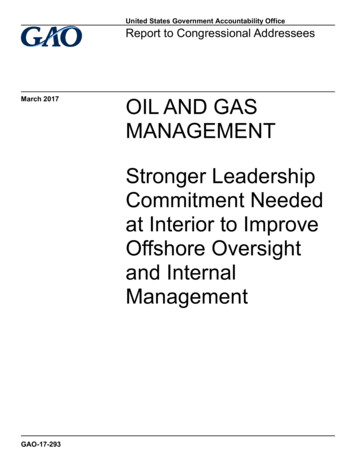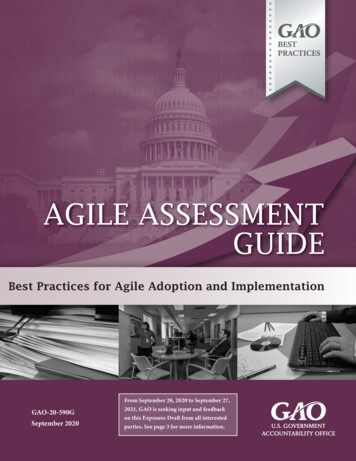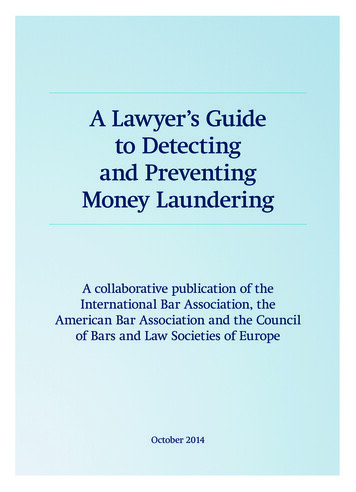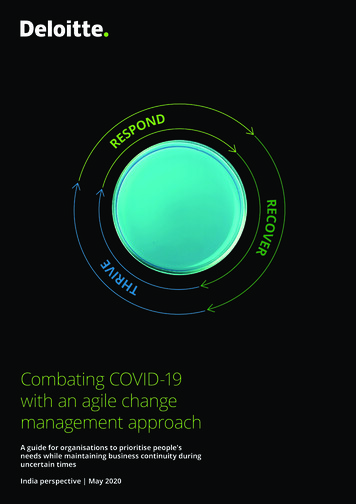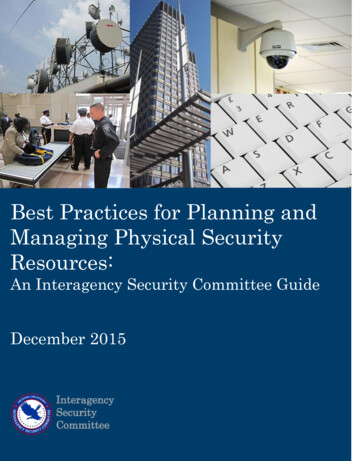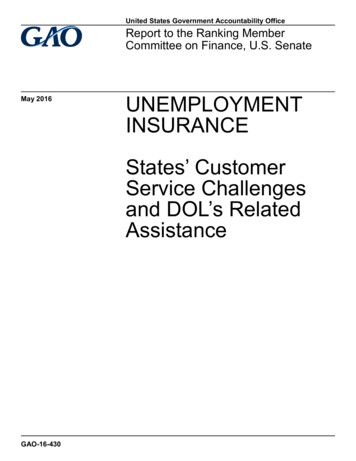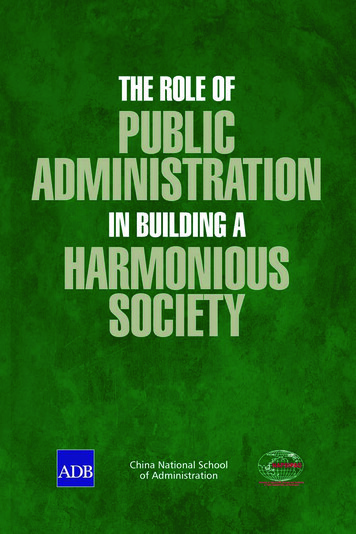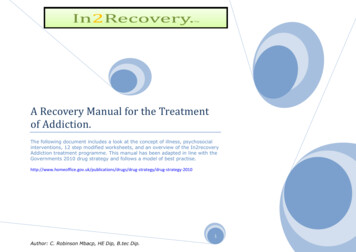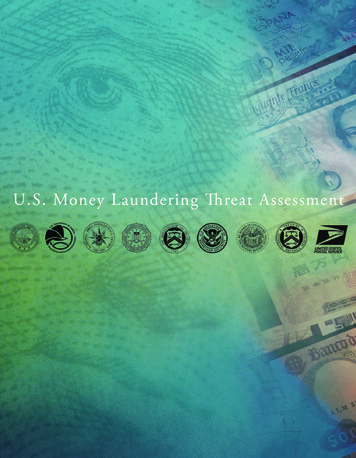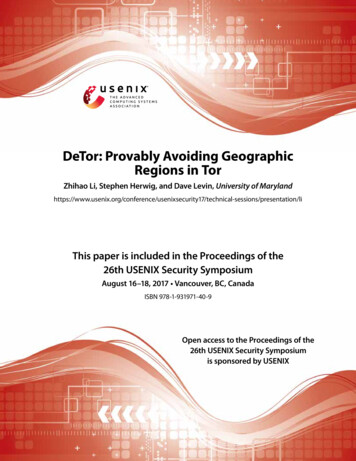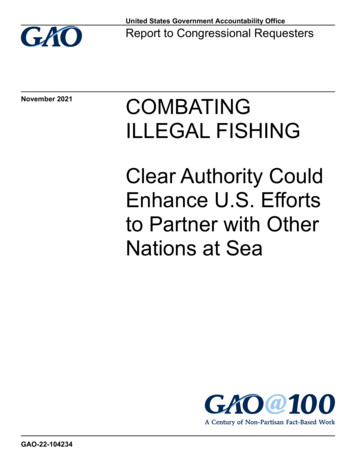
Transcription
United States Government Accountability OfficeReport to Congressional RequestersNovember 2021COMBATINGILLEGAL FISHINGClear Authority CouldEnhance U.S. Effortsto Partner with OtherNations at SeaGAO-22-104234
November 2021COMBATING ILLEGAL FISHINGClear Authority Could Enhance U.S. Efforts to Partnerwith Other Nations at SeaHighlights of GAO-22-104234, a report tocongressional requestersWhy GAO Did This StudyWhat GAO FoundIUU fishing undermines the economicand environmental sustainability of thefishing industry in the U.S. andglobally. IUU fishing encompassesmany illicit activities, including underreporting the number of fish caughtand using prohibited fishing gear.While the illicit nature of IUU fishingmeans its consequences can only beestimated, a recent study estimatescatches from IUU fishing could causeglobal economic losses up to 50billion annually. A variety of federalagencies coordinate with one another,as well as internationally, to addressIUU fishing at sea.The U.S. works with other nations through multilateral agreements to collectivelymanage high seas fisheries. For example, the U.S. is a member of nine regionalfisheries management organizations (RFMO), which are treaty-basedorganizations of nations with an interest in managing and conserving fisheries inspecific regions of the sea. These organizations establish rules for vesselsfishing in the RFMO agreement area, such as limits on the numbers and types offish that can be caught. In addition, the U.S. establishes bilateral agreements andconducts at-sea operations focused on strengthening other nations’ capacity tomanage their own fisheries and fleets. For example, the Department of Defense(DOD) leads a program aimed at building African partner nations’ capability toenhance maritime security and enforce their maritime laws. However, DODofficials told us that, as a result of changes to the 2017 National DefenseAuthorization Act, the department no longer has clear authority to conduct theoperational phase of this program—known as Operation Junction Rain. Bydetermining whether it has the authority to conduct this operation, and, if not,seeking such authority, DOD could continue efforts to support African partnernations’ capability to enforce fisheries laws and regulations, which in turn helpsthem work to counter illegal, unreported, and unregulated (IUU) fishing.GAO was asked to review federalefforts to combat IUU fishing outside ofU.S. waters. This report examines howthe U.S. (1) works with other nations toaddress IUU fishing at sea, (2)identifies potential incidents of IUUfishing at sea, and (3) coordinates itsinteragency efforts to combat IUUfishing at sea and the extent to whichselected efforts are consistent withleading collaboration practices. GAOreviewed various internationalagreements and the mechanisms thatsupport these efforts, as well as otherrelevant agency documents. We alsospoke with officials from the U.S. CoastGuard, NOAA, and DOD, amongothers, about their approaches toidentifying and combating IUU fishingat sea.What GAO RecommendsGAO is making one recommendationto the Department of Defense todetermine whether it has the authorityto continue Operation Junction Rainand, if not, seek the authority to do so.DOD partially concurred with ourrecommendation.View GAO-22-104234. For more information,contact Cardell D. Johnson at (202) 512-3841or JohnsonCD1@gao.gov.Coast Guard Officials Preparing to Board and Inspect a Fishing VesselThe U.S. collects and analyzes information from various sources to identifypotential IUU fishing at sea outside of U.S. waters. For example, Coast Guardanalyzes vessel location data to identify movements that may signal potentialIUU fishing, and officials told us they use this data analysis to help to guide atsea patrol operations to target these vessels.Several interagency groups and processes help coordinate federal efforts tocombat IUU fishing at sea. For example, an interagency working group,established by the Maritime Security and Fisheries Enforcement Act in 2019,coordinates U.S. efforts to address IUU fishing government-wide. We found thatthe working group generally followed selected leading collaboration practices,such as developing a written work plan. The working group’s tasks includeassessing areas for increased agency information-sharing on IUU fishing-relatedmatters, identifying priority regions and nations, and developing a 5-yearstrategic plan to combat IUU fishing and enhance maritime security.United States Government Accountability Office
ContentsLetter1BackgroundU.S. Works with Other Nations to Address IUU Fishing throughAgreements and Capacity-Building Efforts, but DOD LacksClarity on Its Authority to Fully Execute Some EffortsU.S. Leverages Various Information Sources to Identify PotentialIUU Fishing At SeaInteragency Groups and Processes Help Coordinate U.S. Effortsto Combat IUU Fishing at Sea, and the Maritime SAFE ActWorking Group Generally Followed Selected LeadingCollaboration PracticesConclusionsRecommendation for Executive ActionAgency Comments and Our EvaluationAppendix I491620282929Members of the Maritime SAFE Act Working Group onIUU Fishing31Appendix IIComments from the Department of Defense33Appendix IIIGAO Contact and Staff Acknowledgments35TableTable 1: U.S. Agency Roles in International Efforts to CombatIUU fishingPage i9GAO-22-104234 Combating Illegal Fishing
FiguresFigure 1: Maritime Zones of the OceansFigure 2: Common Types of Illegal, Unreported, and UnregulatedFishingFigure 3: Coast Guard Vessel Interdicting Illegal Fishing andOfficials Preparing to Conduct a Law EnforcementBoardingFigure 4: Maritime Security and Fisheries Enforcement (SAFE) ActWorking Group’s Implementation of Selected LeadingCollaboration Practices, as of June ime SAFE ActMOTRNMIONOAARFMOUNCLOSVIIRSVMSU.S. Africa CommandAutomatic identification systemDepartment of DefenseExclusive economic zoneUnited Nations Food and Agriculture OrganizationIllegal, unreported, and unregulatedMaritime Security and Fisheries Enforcement ActMaritime Operational Threat ResponseNational Maritime Intelligence-Integration OfficeNational Oceanic and Atmospheric AdministrationRegional fisheries management organizationUnited Nations Convention on the Law of the SeaVisible Infrared Imaging Radiometer SuiteVessel monitoring systemThis is a work of the U.S. government and is not subject to copyright protection in theUnited States. The published product may be reproduced and distributed in its entiretywithout further permission from GAO. However, because this work may containcopyrighted images or other material, permission from the copyright holder may benecessary if you wish to reproduce this material separately.Page iiGAO-22-104234 Combating Illegal Fishing
Letter441 G St. N.W.Washington, DC 20548November 5, 2021The Honorable Roger F. WickerRanking MemberCommittee on Commerce, Science, and TransportationUnited States SenateThe Honorable Dan SullivanRanking MemberSubcommittee on Oceans, Fisheries,Climate Change, and ManufacturingCommittee on Commerce, Science, and TransportationUnited States SenateThe Honorable John ThuneUnited States SenateIllegal, unreported, and unregulated (IUU) fishing undermines theeconomic and environmental sustainability of fisheries and fish stocks,both in the U.S. and globally. 1 Potential effects of IUU fishing also includejeopardizing food and economic security and benefitting transnationalcrime by supporting illicit networks, such as narcotics trafficking or othercriminal activities at sea. IUU fishing encompasses many illicit activities,ranging from underreporting the number and types of fish caught to usingprohibited fishing gear, such as illegal driftnets. 2 The illicit nature of IUUfishing means that the size of the problem and its negative consequencescan only be roughly estimated; however, according to estimates in arecent study, global illicit trade in catches from IUU fishing causes lossesof up to 50 billion dollars annually from legitimate markets. 31Afishery refers to one or more stocks of fish that can be treated as a unit forconservation and management purposes and that are identified on the basis ofgeographical, scientific, technical, recreational, and economic characteristics. 16 U.S.C. §1802(13)(A). A stock of fish refers to a species, subspecies, geographical grouping, orother category of fish capable of being managed as a unit. Id. § 1802(42). A stock of fishmay be one species or a group of comparable species.2Driftnetfishing is a method using large nets that are allowed to drift with the current andthat are designed to entangle fish in the net’s webbing.3U.R.Sumaila, D. Zeller, L. Hood, M.L.D. Palomares, Y. Li, and D. Pauly, “Illicit Trade inMarine Fish Catch and Its Effects on Ecosystems and People Worldwide,” ScienceAdvances, vol. 6, no. 9 (2020).Page 1GAO-22-104234 Combating Illegal Fishing
The U.S. is one of many nations working to combat IUU fishing, and avariety of federal agencies are involved in U.S. efforts to address thisglobal issue. For example, the U.S. Coast Guard, which is a componentof the Department of Homeland Security, is the lead agency for at-sealaw enforcement. The Department of Defense (DOD) engages in at-seaexercises with other countries to help partner nations build maritimesecurity capacity, which officials say can contribute to combating IUUfishing. The National Oceanic and Atmospheric Administration (NOAA),within the Department of Commerce, has subject matter expertise infisheries management and fisheries law enforcement. Within NOAA, theOffice of General Counsel and the National Marine Fisheries Service’sOffice of Law Enforcement and Office of International Affairs and SeafoodInspection have roles in combating IUU fishing at sea, according to NOAAofficials. The State Department has a role in negotiating andimplementing international treaties and agreements that address IUUfishing in coordination with other nations. The National MaritimeIntelligence-Integration Office (NMIO) facilitates information sharing andcollaboration across the Global Maritime Community of Interest, whichconsists of federal, state, local, tribal, and territorial governments; themaritime industry; academia; and international partners. 4You asked us to review federal efforts to combat IUU fishing outside ofU.S. waters. 5 This report examines how the U.S. (1) works with othernations to address IUU fishing at sea, (2) identifies potential incidents ofIUU fishing at sea, and (3) coordinates its interagency efforts to combatIUU fishing at sea and the extent to which selected efforts are consistentwith leading collaboration practices.To describe how the U.S. works with other nations to address IUU fishing,we reviewed various multi- and bilateral agreements the U.S. hasestablished with other nations, as well as summaries of thoseagreements. For example, we reviewed collective agreements to whichthe U.S. is a member, such as agreements establishing regional fisheriesmanagement organizations (RFMO), and other multilateral agreements,4TheOffice of the Director of National Intelligence, in cooperation with the Navy and theCoast Guard, created NMIO in 2009 to advance governmental collaboration and unity ofeffort.5Ourreport focuses on operations at sea, but excludes efforts within U.S. territorialwaters, which generally extend up to 12 nautical miles from the coastline, as well as theU.S. exclusive economic zone, which generally extends up to 200 nautical miles from thecoastline.Page 2GAO-22-104234 Combating Illegal Fishing
such as the Port State Measures Agreement. We also reviewed bilateralshiprider agreements. 6 Additionally, we interviewed relevant agencyofficials about the development and implementation of these agreements,including officials from the Coast Guard, NOAA, State Department, DOD,and NMIO.To describe how the U.S. identifies potential incidents of IUU fishing atsea, outside of U.S. waters, we reviewed documents and interviewedagency officials about the information used to identify potential IUUfishing at sea and how it is obtained. For example, we discussed thecollection and use of vessel location data, as well as the planning andoperation of Coast Guard at-sea patrols. We also spoke with Coast Guardofficials about U.S. boardings and inspections of foreign-flagged vesselsoutside of U.S. waters.To identify and describe how the U.S. coordinates its interagency effortsto combat IUU fishing at sea, we reviewed documents and interviewedofficials about interagency collaboration through the Maritime Securityand Fisheries Enforcement (SAFE) Act IUU fishing working group andother interagency working groups, including the International MaritimeDomain Awareness Working Group. 7 For the Maritime SAFE Act workinggroup, we reviewed documents, including a work plan and meetingsummaries. To discuss the early operations of the group since itsinception in December 2019, we also spoke with officials from NOAA,which chairs the group; the Coast Guard; State Department; DOD; andNMIO. We compared the interagency collaboration to date with selectedleading practices for interagency collaboration identified in our past work. 8We focused on applying those leading practices to the Maritime SAFE Actworking group because it is designed to facilitate a government-wideapproach to addressing IUU fishing. We selected five of the sevenleading collaboration practices because they were the most relevant to6Bilateralshiprider agreements are agreements which allow a law enforcement officialfrom one party to embark on a law enforcement vessel of the other party. Theseagreements are designed to help partner nations enforce fisheries law and to preparepersonnel from those nations for independent enforcement of fisheries law in the longterm.7TheMaritime SAFE Act was enacted as part of the National Defense Authorization Actfor Fiscal Year 2020. Pub. L. No. 116-92, div. C, tit. XXXV, subtit. C, 133 Stat. 1997(2019). Among other things, the SAFE Act established a collaborative interagency workinggroup on maritime security and IUU fishing. Id. § 3531.8GAO,Managing for Results: Key Considerations for Implementing InteragencyCollaborative Mechanisms, GAO-12-1022 (Washington, D.C.: Sept. 27, 2012).Page 3GAO-22-104234 Combating Illegal Fishing
the working group. The five leading practices we selected were: (1)identifying and sustaining leadership, (2) including relevant parties, (3)developing and updating written guidance and agreements, (4) clarifyingroles and responsibilities, and (5) defining outcomes and monitoringaccountability.We conducted this performance audit from April 2020 to September 2021in accordance with generally accepted government auditing standards.Those standards require that we plan and perform the audit to obtainsufficient, appropriate evidence to provide a reasonable basis for ourfindings and conclusions based on our audit objectives. We believe thatthe evidence obtained provides a reasonable basis for our findings andconclusions based on our audit objectives.BackgroundMaritime ZonesApplicable requirements for fishing vessels at sea, and thus the kinds offishing that are permissible, vary depending on the maritime zone. Anation’s territorial waters are generally a zone extending from a nation’scoastline up to 12 nautical miles away; 9 coastal nations have sovereigntyand jurisdiction over this zone. Beyond and adjacent to the territorial sea,coastal nations generally have an exclusive economic zone (EEZ) up to200 nautical miles from their coastlines. 10 In this zone, a coastal nationhas certain rights, including sovereign rights for the purpose of exploringand exploiting, conserving, and managing the natural resources of thewaters.Beyond EEZs, the ocean is generally defined as “high seas” and isconsidered international waters. According to a report from thenongovernmental organization Pew Charitable Trusts, the high seasrepresent approximately two-thirds of the world’s oceans. Figure 1illustrates the locations of maritime zones.9Territorialsea begins at a nation’s baseline, which is defined in the 1982 United NationsConvention on the Law of the Sea (UNCLOS) as generally the low-water line along thecoast as marked on large-scale charts officially recognized by the coastal nation. For thepurposes of this report, we call this a nation’s coastline.10Internationallaw governing exclusive economic zones (EEZ) was established byUNCLOS. The U.S. is not a party to UNCLOS; however, according to officials from NOAAand the State Department, the U.S. recognizes that UNCLOS reflects customaryinternational law.Page 4GAO-22-104234 Combating Illegal Fishing
Figure 1: Maritime Zones of the OceansOn the high seas, vessels are subject to the laws of their flag state. 11Additionally, because flag states commit to implementing internationalagreements and conventions to which they are a member, a nation’svessels are subject to applicable rules established by internationalagreements and conventions, as implemented by the nation. Theseagreements and conventions, including RFMO agreements, generallycover specific geographic regions of the high seas. RFMOs are treatybased international bodies comprising nations that share an interest inmanaging and conserving fisheries in specific regions of the high seas. 12RFMOs establish binding conservation measures to manage and11The flag state of a vessel is the nation of jurisdiction under whose laws the vessel isregistered or licensed and is deemed the nationality of the vessel.12The U.S. belongs to nine RFMOs where the U.S. is a coastal nation or has a fishinginterest, according to State Department officials: (1) North Pacific Fisheries Commission,(2) Northwest Atlantic Fisheries Organization, (3) International Commission for theConservation of Atlantic Tunas, (4) Western and Central Pacific Fishery Commission, (5)Inter-American Tropical Tuna Commission, (6) Commission for the Conservation ofAntarctic Marine Living Resources, (7) South Pacific Regional Fishery ManagementOrganization, (8) The North Atlantic Salmon Conservation Organization and (9) the NorthPacific Anadromous Fish Commission. Additionally, the U.S. acts as an observer to otherRFMOs covering fisheries that are harvested for U.S. import. There are also a number ofother international fishing agreements that function similarly but that are not consideredRFMOs by the State Department. According to a report from the nongovernmentalorganization Pew Charitable Trusts, there are approximately 17 RFMOs worldwide.Page 5GAO-22-104234 Combating Illegal Fishing
conserve particular species of fish or other living marine resources withinspecific geographic regions of the oceans. For example, the InternationalCommission for the Conservation of Atlantic Tunas RFMO agreementestablishes a limit on allowable catch of certain species of tuna within theagreement area. Violations of RFMO conservation measures aregenerally considered IUU fishing.Definition of IUU FishingIUU fishing is a broad term that generally includes activities that violatenational law or international fishing regulations or agreements. 13 NOAAdefines each aspect of IUU fishing as follows: Illegal fishing refers to fishing activities conducted in contravention ofapplicable laws and regulations, including those adopted at theregional and international level. Unreported fishing refers to fishing activities that are not reported orare misreported to relevant authorities in contravention of nationallaws and regulations or reporting procedures of a relevant RFMO. Unregulated fishing occurs in geographic areas or for specificspecies of fish for which there are no applicable conservation ormanagement measures, and when fishing activities are conducted ina manner inconsistent with a nation’s responsibilities for theconservation of living marine resources under international law.Fishing activities are also unregulated when occurring in an RFMOmanaged area and conducted by vessels without nationality, or bythose flying a flag of a nation or fishing entity that is not party to theRFMO, in a manner inconsistent with the conservation measures ofthat RFMO. 14IUU fishing encompasses many illicit activities that can occur both withina nation’s EEZ as well as on the high seas. For example, within nationalEEZs, vessels may engage in IUU fishing by fishing without anappropriate license or fishing above a nationally established quota. On13Although human trafficking and forced labor are illegal under U.S. law, they are notgenerally included in regulatory definitions of IUU fishing, including the definition under theHigh Seas Driftnet Moratorium Protection Act or the definition in the Maritime SAFE Act.For the purposes of this report, IUU fishing does not include fishing with forced labor.14Under the Maritime SAFE Act, the term IUU fishing means illegal fishing, unreportedfishing, or unregulated fishing as such terms are defined in paragraph 3 of theInternational Plan of Action to Prevent, Deter, and Eliminate Illegal, Unreported andUnregulated Fishing, adopted at the 24th Session of the Committee on Fisheries in Romeon March 2, 2001. NOAA’s definitions, above, are also based on the definitions in theInternational Plan of Action.Page 6GAO-22-104234 Combating Illegal Fishing
the high seas, examples of IUU fishing include fishing out of season orfishing in a prohibited area. Figure 2 below illustrates common types ofIUU fishing.Figure 2: Common Types of Illegal, Unreported, and Unregulated FishingU.S. Laws and FederalAgenciesThe U.S. works through international relationships to combat IUU fishingon the high seas. In doing so, U.S. jurisdiction is generally limited to itsown flagged vessels; however, some domestic laws are relevant to U.S.efforts to combat IUU fishing by foreign-flagged vessels operating outsideof U.S. waters, including the following: The Maritime SAFE Act was enacted in 2019 for several purposes,including to support a government-wide approach to counter IUUfishing and related threats to maritime security; improve data sharingthat enhances surveillance, enforcement, and prosecution againstIUU fishing and related activities at a global level; and supportcoordination and collaboration to counter IUU fishing internationally inPage 7GAO-22-104234 Combating Illegal Fishing
priority regions. 15 The act established, among other things, aninteragency working group on maritime security and IUU fishing. Forthe purposes of this report, we refer to this group as the MaritimeSAFE Act working group. The High Seas Fishing Driftnet Moratorium Protection Actprohibits the U.S. from entering into international agreements thatwould prevent full implementation of the UN Moratorium on LargeScale High Seas Driftnets. 16 The act, and the statutes implementingthe various RFMO conventions that the United States is party to,apply to U.S. vessels, but the U.S. can also apply those laws tostateless vessels operating on the high seas as if they were U.S.vessels. The Magnuson-Stevens Fishery Conservation and ManagementReauthorization Act of 2006, which amended the High Seas DriftnetFishing Moratorium Protection Act, established a process foridentifying nations for IUU fishing in a biennial report to Congress. 17Efforts to combat IUU fishing on the high seas require coordination andinformation sharing among a number of federal agencies that havedifferent roles and responsibilities. (See table 1.)15Pub.L. No. 116-92, div. C, tit. XXXV, subtit. C, §§ 3531-3572, 133 Stat. 1997 (2019)(codified at 16 U.S.C. §§ 8001-8041).16Pub.L. No. 104-43, tit. VI, 109 Stat. 391 (1995) (codified as amended at 16 U.S.C. §§1826d-1826k).17Pub.L. No. 109-479, § 403(a), 120 Stat. 3575, 3626 (codified as amended at 16 U.S.C.§ 1826h). For the biennial reports produced since 2009, port-iuu-fishing-bycatch-and-shark-catch.Once a nation or entity is identified in the biennial report, NOAA enters into a two-yearconsultation period to press for necessary measures to address the issue for which it wasidentified. Following these consultations, NOAA determines whether to negatively orpositively certify the identified nation or entity in the next report to Congress. A positivecertification is issued if the nation has provided evidence of actions that address theactivities for which it was identified. A negative certification may result in denial of U.S.port access for fishing vessels of that nation and potential import restrictions on fish or fishproducts.Page 8GAO-22-104234 Combating Illegal Fishing
Table 1: U.S. Agency Roles in International Efforts to Combat IUU fishingAgencyKey roles and responsibilitiesNational Oceanic andAtmospheric Administration(NOAA), within the Departmentof CommerceNOAA has subject matter expertise on fisheries management and illegal, unreported, andunregulated (IUU) fishing; accordingly, it consults with the State Department in negotiations ofsome international agreements, and it represents U.S. efforts in some multilateral agreements thatmanage high seas and shared fisheries. NOAA also works with other nations to strengthenenforcement and data collection programs and participates in some at-sea exercises with suchpartner nations. Additionally, according to NOAA officials, the agency can enforce U.S. marineresource laws, including those targeting IUU fishing and trafficking in IUU fish and fish products.U.S. Coast GuardThe Coast Guard generally serves as the lead agency for at-sea enforcement of internationalfisheries agreements—including boarding and inspecting vessels suspected of IUU fishing, whichit can do under the authority of some regional fisheries management organizations—and foridentifying potential IUU fishing at sea. The Coast Guard also works closely with other nations inefforts to build capacity to manage their own fisheries and fleets.State DepartmentThe State Department leads diplomatic efforts, including negotiating new RFMOs and otherinternational agreements, and maintains contact with other nations during implementation of theseagreements. It also coordinates with other nations through diplomatic channels in cases wherevessels flagged under those nations are identified as engaging in IUU fishing and a governmentto-government approach to addressing the potential violation is necessary.Department of Defense (DOD)DOD engages in periodic at-sea exercises with other countries to help build other nations’maritime security. It generally does so though its geographic combatant commands. According toDOD officials, these exercises build partner nations’ maritime security capacity, which can helpthem to manage their own fisheries and fleets.NavyThe Navy contributes expertise, personnel, and resources for training and building partner nations’capacity to provide maritime security. According to DOD officials, such capacity can help partnernations manage their own fisheries.National Maritime IntelligenceIntegration Office (NMIO)Established by the Office of the Director of National Intelligence, which is administered by theNavy, NMIO facilitates maritime information sharing within the government and provides unifiedintelligence support to U.S. policymakers.Source: GAO analysis of agency information. GAO-22-104234U.S. Works withOther Nations toAddress IUU Fishingthrough Agreementsand Capacity-BuildingEfforts, but DODLacks Clarity on ItsAuthority to FullyExecute Some EffortsThe U.S. works with other nations through multilateral agreements todevelop measures to collectively manage high seas fisheries. In addition,the U.S. establishes bilateral agreements focused on building othernations’ capacity to manage their own fisheries and fleets, including DODexercises with partner nations designed to increase other nations’maritime security, which can include building fisheries law enforcementcapacity. However, DOD lacks clarity on whether it has all the necessaryauthority to conduct parts of its capacity-building efforts in Africa.Page 9GAO-22-104234 Combating Illegal Fishing
U.S. Works with OtherNations throughMultilateral Agreements forCollective Management ofHigh Seas FisheriesThe U.S. is a member of various multilateral agreements with othernations to collectively and sustainably manage high seas fisheries andcombat IUU fishing. Through RFMO agreements, the U.S. workscollectively with other member nations to patrol areas of the high seascovered by RFMOs to identify potential IUU fishing. For example,Operation North Pacific Guard is an IUU fishing-focused operation byJapan, China, Russia, South Korea, Canada, and the U.S. that patrolsareas of the northern Pacific Ocean covered by three RFMOagreements. 18 In 2019, this operation identified 58 violations of RFMOconservation measures. The vessels were reported to the relevantRFMOs and their individual flag states for further action. See figure 3below for photos of a Coast Guard vessel interdicting a vessel using anillegal high seas driftnet, and Coast Guard officials preparing to conduct alaw enforcement boarding under measures established by the Westernand Central Pacific Fisheries Commission RFMO.Figure 3: Coast Guard Vessel Interdicting Illegal Fishing and Officials Preparing to Conduct a Law Enforcement BoardingThe U.S. and other RFMO member nations collaborate to ensureviolations of RFMO conservation measures are addressed. When U.S.officials identify potential violations, they work with other RFMO membernations and relevant flag states to take appropriate actions. For example,in 2020, the Coast Guard identified a vessel violating the International18Theoperation patrols areas covered by the North Pacific Fisheries Commission,Western and Central Pacific Fisheries Commission, and North Pacific AnadromousFisheries Commission RFMO agreements.Page 10GAO-22-104234 Combating Illegal Fishing
Commission for the Conservation of Atlantic Tunas
globally. IUU fishing encompasses many illicit activities, including under-reporting the number of fish caught and using prohibited fishing gear. While the illicit nature of IUU fishing means its consequences can only be estimated, a recent study estimates catches from IUU fishing could
